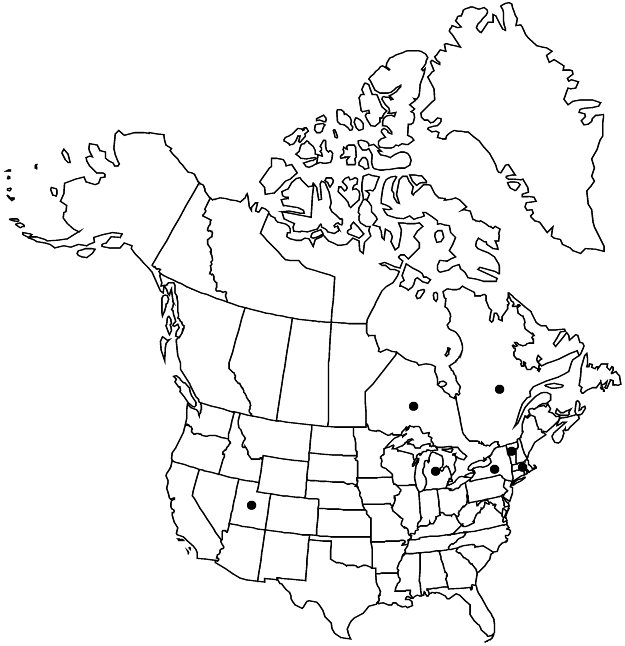Difference between revisions of "Sedum hispanicum"
Cent. Pl. I, 12. 1755 ,.
FNA>Volume Importer |
imported>Volume Importer |
||
| (4 intermediate revisions by 2 users not shown) | |||
| Line 7: | Line 7: | ||
}} | }} | ||
|common_names=Orpin d’Espagne | |common_names=Orpin d’Espagne | ||
| + | |special_status={{Treatment/ID/Special_status | ||
| + | |code=I | ||
| + | |label=Introduced | ||
| + | }} | ||
|basionyms= | |basionyms= | ||
|synonyms= | |synonyms= | ||
| Line 23: | Line 27: | ||
|elevation=0-1000 m | |elevation=0-1000 m | ||
|distribution=Ont.;Que.;Mass.;Mich.;N.Y.;Utah;Vt.;s;c Europe (Balkan Peninsula;Caucasus region);sw Asia (n Iran;Lebanon;Palestine;Turkey). | |distribution=Ont.;Que.;Mass.;Mich.;N.Y.;Utah;Vt.;s;c Europe (Balkan Peninsula;Caucasus region);sw Asia (n Iran;Lebanon;Palestine;Turkey). | ||
| + | |introduced=true | ||
|discussion=<p><i>Sedum hispanicum</i> has been naturalized in North America since 1880; it is sometimes cultivated.</p> | |discussion=<p><i>Sedum hispanicum</i> has been naturalized in North America since 1880; it is sometimes cultivated.</p> | ||
|tables= | |tables= | ||
| Line 32: | Line 37: | ||
-->{{#Taxon: | -->{{#Taxon: | ||
name=Sedum hispanicum | name=Sedum hispanicum | ||
| − | |||
|authority=Linnaeus | |authority=Linnaeus | ||
|rank=species | |rank=species | ||
| Line 47: | Line 51: | ||
|publication title=Cent. Pl. I, | |publication title=Cent. Pl. I, | ||
|publication year= | |publication year= | ||
| − | |special status= | + | |special status=Introduced |
| − | |source xml=https:// | + | |source xml=https://bitbucket.org/aafc-mbb/fna-data-curation/src/2e0870ddd59836b60bcf96646a41e87ea5a5943a/coarse_grained_fna_xml/V8/V8_431.xml |
|genus=Sedum | |genus=Sedum | ||
|species=Sedum hispanicum | |species=Sedum hispanicum | ||
Latest revision as of 22:43, 5 November 2020
Herbs, annual, tufted, glabrous or scattered glandular-hairy. Stems erect or ascending, simple or much-branched, (glandular-hairy), not bearing rosettes. Leaves alternate, ascending, sessile; blade green, sometimes glaucous, linear to oblong, semiterete or ± laminar, 4–20 × 1–2 mm, base not spurred, not scarious, apex obtuse, (surfaces usually glabrous or, rarely, glandular-hairy). Flowering shoots spreading or erect, simple, 5–15 cm, (glabrous or with scattered glandular hairs); leaf blades linear to oblong, base not spurred; offsets not formed. Inflorescences lax to ± dense cymes, 2–8-flowered or flowers solitary, 2–4-branched; branches not recurved, not forked; bracts similar to leaves, smaller. Pedicels to 0.5 mm. Flowers 5–9-merous; sepals erect, connate basally, green, broadly triangular, equal, ca. 2 × 1 mm, apex acute, (glandular-pubescent); petals spreading, distinct, white with pinkish midvein, lanceolate, not carinate, 4–5(–7) mm, apex narrowly acuminate; filaments white; anthers dark purple; nectar scales white, spatulate-quadrate. Carpels stellate-spreading in fruit, connate basally, white or pale pink. 2n = 40.
Phenology: Flowering spring–summer.
Habitat: Rocks and waste places
Elevation: 0-1000 m
Distribution

Introduced; Ont., Que., Mass., Mich., N.Y., Utah, Vt., s, c Europe (Balkan Peninsula, Caucasus region), sw Asia (n Iran, Lebanon, Palestine, Turkey).
Discussion
Sedum hispanicum has been naturalized in North America since 1880; it is sometimes cultivated.
Selected References
None.